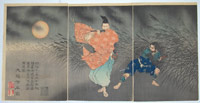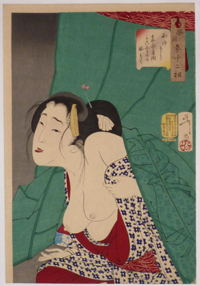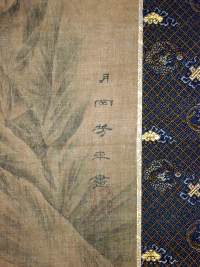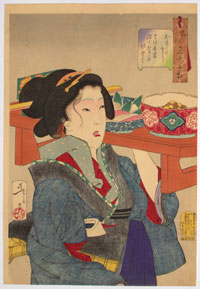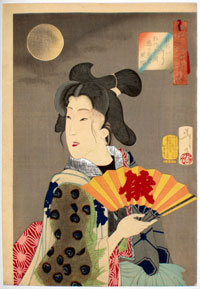Tsukioka YOSHITOSHI (1832 – 1892)
Click here to view image full size.
A triptych showing a massive exploding mine throwing bodies into the air. Title: Taiheiki Masakiyo nansen no zu, “Masakiyo’s Difficult Battle from the Taiheiki Chronicles.” Published 10/1866 by Yamajin. Although set in the fourteenth century, in fact this is a comment on the recent ( spring of 1866 ) campaign of the Tokugawa Shogun Iemochi. He had temporarily defeated the dissident Choshu samurai who had shelled the Shogun’s palace in Edo in 7/1864. Sato Masakiyo on horseback is probably meant to represent the famous general Kato Kiyomasa. One of Yoshitoshi’s great designs and a similar composition is used by him in several of his picture books.
Fine impression and colour. Slight vertical centre folds strengthened au verso, otherwise good condition. Signed Ikkaisai Yoshitoshi hitsu.
Status: Sold
Tsukioka YOSHITOSHI (1832 – 1892)
Click here to view image full size.
The Heian courtier Fujiwara no Yasumasa playing the flute by moonlight. Based on a
painting Yoshitoshi exhibited at the Exhibition for the Advancement of Painting in the
autumn of 1882. The story relates that while Fujiwara no Yasumasa was playing on Ichihara Moor he was approached by the bandit Kidomaru who intended to kill him. Instead he was overcome by the beauty of the music and gave up his plan. Yoshitoshi’s painting was so well received, the subject was incorporated into a play with Ichikawa Danjuro IX playing Fujiwara no Yasumasa several months after the publication of the print. Published 1883 by Akiyama Buemon. Considered by cogniscenti to be Yoshitoshi’s finest design.
Superb impression of the utmost finesse. This appears to be the only illustrated example with the background clouds wiped from left to right. The “proof” impression in The Philadelphia Museum of Art is annotated “Please print the background colour this way” [ clouds wiped right to left ]. Fine colour. Minimal shaving bottom centre sheet and a slight discoloration on last sheet, otherwise fine condition with extra paper for joining. Signed Oju Taiso Yoshitoshi sha.
Status: Sold
Tsukioka YOSHITOSHI (1839 – 1892)
Click here to view image full size.
Snow from the set Setsugekka no uchi, “Snow, Moon and Flowers” published by Akiyama Buemon, 1890. Shows half-length portraits of famous actors, in this case Onoe Baiko V ( Onoe Kikugoro V, 1844-1903 ) as the priest Iwakura Sogen. Various versions of the story and play exist concerning Sogen’s infatuation with Irokotohime. First edition ( the second state titled “Iwakura Sogen in the Hermitage Scene from Hanafubuki” ).
Superb impression, colour and condition. Totally untrimmed with extra paper all round. Signed Yoshitoshi.
Status: Sold
Tsukioka YOSHITOSHI (1839 – 1892)
Click here to view image full size.
The best design from the set Tsuki hyakushi, the “Hundred Phases of the Moon”. The set published between 1885 and 1892 ( this being 1886 ) by Akiyama Buemon. Shows Benkei, at the prow of the ship holding Yoshitsune, attempting to pacify the ghosts of the Taira warriors and hence calm the storm. The finest impression of this design I have catalogued.
Superb impression, fine colour and condition with large margins. Strong wood grain evident and scattered mica. This impression, never having been in an album, avoids the offsetting which often spoils this design because of its position in album form. Signed Yoshitoshi.
Status: Sold
Tsukioka YOSHITOSHI (1839 – 1892)
Click here to view image full size.
Gikeiki gojobashi no zu. Shows Ushiwaka and Benkei duelling on Gojo Bridge. An episode from the Chronicles of Yoshitsune, 1881. This impression is unlike any other illustrated example: The moon does not have a printed outline and there are delicately wiped clouds across it.
Very good impression and colour. Slight trimming and retains original album backing. Signed Taiso Yoshitoshi ga.
Status: Sold
Tsukioka YOSHITOSHI (1839 – 1892)
Click here to view image full size.
Nippon ryakushi, “A Brief History of Japan”. Shows Susanoo no Mikoto killing the 8 – headed serpent at Hirokawa in Izumo Province. Published by Izawa Genjiro, 1887. Designed in the same format as the set Dai Nippon shiyaku zue, 1879. An extremely rare triptych.
Very fine impression and colour. Retains original album backing, otherwise very good condition. Signed Taiso Yoshitoshi ga.
Status: Sold
Tsukioka YOSHITOSHI (1839 – 1892)
Click here to view image full size.
Yoshitoshi’s masterpiece. Shows Mongaku ( Endo Morito c 1120-1200 ) subjecting himself to three years penance as a Buddhist monk beneath the waterfall of Mount Nachi in Kii Province. Morito inflicted this punishment on himself because he had inadvertently cut off the head of Kesa Gozen, the wife of the palace guard Watanabe Wataru, with whom he was in love. Published 1859 ( centre sheet ) and 1860 ( outside panels ) by Kadokin. Extremely rare: Another ( trimmed ) impression in the Baur collection, Geneve, Switzerland.
Fine impression, very good colour. Minor marks, otherwise very good condition. Extensive splashed gofun. Full size with extra paper around. Signed Ikkaisai Yoshitoshi hitsu.
Status: Sold
Tsukioka YOSHITOSHI (1839 – 1892)
Click here to view image full size.
A diptych showing Urashima Taro returning home from the palace of the Dragon King from the set Yoshitoshi manga, “Sketches by Yoshitoshi”. Published by Kobayashi, Meiji 19 ( 1/1886 ). First edition. ( It was republished by Hasegawa 1887.)
Very good impression and colour with margin for joining. Minor backed wormhole otherwise very good condition. Signed Yoshitoshi ga.
Status: Sold
Tsukioka YOSHITOSHI (1839-1892)
Click here to view image full size.
An uncut sheet of two chuban prints showing Kobayakaw Saemon Koretaka and Saito Musashibo Benkei from the set: Wakan kidan kagami, “A Comparison of Strange Stories from China and Japan.”” The set published 1880 by Kodama Mathichi.
Very good to fine impression, colour and condition. Variegated cartouche. Signed Yoshitoshi ga.
Status: Sold
Tsukioka YOSHITOSHI (1839-1892)
Click here to view image full size.
An uncut sheet of two chuban prints showing Toki Daishoro and Chinsei Hachiro Minamoto Tameasa from the set: Wakan kidan kagami, “A Comparison of Strange Stories from China and Japan.” The set published 1880 by Kodama Mathichi.
Very good to fine impression, colour and condition. Variegated cartouche. Signed Yoshitoshi ga.
Status: Sold
Tsukioka YOSHITOSHI (1839-1892)
Click here to view image full size.
An uncut sheet of two chuban prints showing Tahara Fujita Hidesato and Kodan Uzaemon Naoyuki from the set: Wakan kidan kagami, “A Comparison of Strange Stories from China and Japan.” The set published 1880 by Kodama Mathichi.
Very good to fine impression, colour and condition. Variegated cartouche. Signed Yoshitoshi ga.
Status: Sold
Tsukioka YOSHITOSHI (1839-1892)
Click here to view image full size.
An uncut sheet of two chuban prints showing Skura Sogo and Sakenomi Doji from the set: Wakan kidan kagami, “A Comparison of Strange Stories from China and Japan.” The set published 1880 by Kodama Mathichi.
Very good to fine impression, colour and condition. Variegated cartouche. Signed Yoshitoshi ga.
Status: Sold
Tsukioka YOSHITOSHI (1839-1892)
Click here to view image full size.
An uncut sheet of two chuban prints showing the Chinese generals Shin Shobu and Tobu Ribu from the set: Wakan kidan kagami, “A Comparison of Strange Stories from China and Japan.” The set published 1880 by Kodama Mathichi.
Very good to fine impression, colour and condition. Variegated cartouche. Signed Yoshitoshi ga.
Status: Sold
Tsukioka YOSHITOSHI (1839 – 1892)
Click here to view image full size.
The demon Ibaraki of Rashomon ( a gate south of the Imperial Palace in Kyoto ) visits Watanabe no Tsuna disguised as an old woman to retrieve its severed arm. This famous story relates how Watanabe cut off the arm after camping out at the gate to rid the neighbourhood of the beast. ( See below on this website for Yoshitoshi’s vertical diptych of the same subject. ) From Yoshitoshi manga, “Sketches by Yoshitoshi” from a fine set of seven diptychs. Published by Kobayashi 1885-86 ( this being 1885 ).
Very fine impression of the first edition. Fine colour. Fine condition apart from one minor mark. As originally published with no backing paper, with the margins completely untrimmed ( often cut in this set ), and plenty of space for joining. Signed Yoshitoshi ga.
Status: Sold
Tsukioka YOSHITOSHI (1839-1892)
Click here to view image full size.
An original preparatory drawing ( hanshita-e ) for an unrecorded and unpublished oban set of Twenty-four Paragons of Filial Piety. The stories originated in China where filial piety is considered the first virtue ( being common to almost all religions in China ). This drawing obviously depicts Kokaku ( Chinese: Chiang Ko or Jiang Ge ) who carried his mother on his back to escape civil war in their village. Sumi and light brown under-drawing on thin paper. Sold “as is” with some creasing and wormage. Signed Yoshitoshi ( signature c 1887-91 ). Ex collection Mizuno Toshikata
Status: Sold
Tsukioka YOSHITOSHI (1839-1892)
Click here to view image full size.
Looking Itchy: The Appearance of a Kept Woman of the Kaei Era ( 1848 – 1854 ). From the set: Thirty-two Aspects of Women published by Tsunashima Kamekichi, 1888. Shows a dishabille beauty emerging from a mosquito net. One of the two or three best designs from the set.
Fine impression of the first edition. Fine colour and condition with the extra paper at left edge and the full handling area showing bottom right. Signed Yoshitoshi ga.
Status: Sold
Tsukioka YOSHITOSHI (1839-1892)
Click here to view image full size.
Looking Itchy: The Appearance of a Kept Woman of the Kaei Era ( 1848-1854 ). From the set Thirty-two Aspects of Women published by Tsunashima Kamekichi, 1888. Shows a dishabille beauty emerging from a mosquito net. One of the two or three best designs from the set.
Very fine impression, colour and condition. Pristine. The first edition. Signed Yoshitoshi ga.
Status: Sold
Tsukioka YOSHITOSHI (1839-1892)
Click here to view image full size.
One volume Shuzo suiko meimei den, Shohen, “ Portraits of the Characters in the Suikoden, First Series.” Original embossed orange covers with yellow title slip. Inside front cover title and signature within a western-style surround. Preface 6 pp. including two double-page colour illustrations, last sheet dated Keio 3 ( 1867 ). And 18 numbered pages with 36 illustrations of Suikoden warriors on yellow grounds. Inside back cover advertisements. Published by Odawaraya Yashichi, Edo. In extremely good condition. Superb engraving ( by Egawa Ichigoro ). Toda gives a third volume but did not know of a second. Rare.
Status: Sold

Click here to view image full size.

Click here to view image full size.

Click here to view image full size.

Click here to view image full size.
Tsukioka YOSHITOSHI (1839-1892)
Click here to view image full size.
Looking Tiresome: The Appearance of a Virgin of the Kansei Era ( 1789 – 1802 ). From the set: Thirty-two Aspects of Women published by Tsunashima Kamekichi, 1888. The young girl strokes a pet cat.
Very fine impression of the first edition with the cat’s fur strongly blind-printed. Fine colour. Miniscule trimming on left, otherwise very good condition. Signed Yoshitoshi ga.
Status: Sold
Tsukioka YOSHITOSHI (1839-1892)
Click here to view image full size.
An important two-fold screen, Yamatotakeruno mikoto at Mount Azuma. Yamatotakeru was the beautiful but fiery tempered third son of the Emperor Keikou (71B.C.-130 A.D.) He also had magical powers given to him by his aunt. His father decided to send him to the Eastern Provinces to subdue the barbarians. On the way aboard a boat, they encountered a violent storm. His wife, Ota-tachibana, threw herself in the sea to appease the Gods and drowned. Yamatotakeru continues his journey and reaches a rocky landscape. He gazes south east and in memory of his wife repeats three times “Azuma haya” (My wife, alas). Thus the mountain and area became known as Azuma. This is the scene Yoshitoshi depicts with Yamatotakeru surrounded by his entourage, gazing ahead, his long hair flowing. (He was able to pass as a woman in disguise, evidently.) Yoshitoshi had a jagged style of drawing and painting and the multitude of craggy outcrops allow him to fully indulge himself.
Full colour on silk, each panel 39.75 x 25 in; 101 x 63.5 cms. Extremely good condition. Signed Kinzaburo Yoshitoshi ga with blurred seal but reading Go Kaisai. Extremely rare.
Status: Sold
Tsukioka YOSHITOSHI (1839-1892)
Click here to view image full size.
An original painting, Hokosorori zu, showing Sorori Shinzaemon (at bottom) and Toyotomi Hideyoshi (1536-1598). Sororai was a sword sheath maker and otogishu to Hideyoshi (storyteller to attending provincial lords). “Sorori” means smooth and quiet, the name given to him because any sword fit his sheaths so perfectly. The episode depicted concerns Hideyoshi lamenting the fact that his face looked like a monkey. Sorori cleverly tells him that he is lucky that monkeys respect him to such a degree that they try to look like him. Hideyoshi enjoys the reply and inquires what he would like as a reward. Sorori asks him for a grain of rice to be doubled-up every day for one hundred days. After this period Hideyoshi realises his mistake and demands that Sorori change the reward.
Full colour on silk, image size 34.75 x 11.5 in; 88.2 x 29.2 cms. In very good condition. Beautiful mount. Signed Yoshitoshi with Taiso seal.
Status: Sold
Tsukioka YOSHITOSHI (1839-1892)
Click here to view image full size.
“Looking Weighed-down: The Appearance of a Waitress at Fukagawa in the Tempo Era” ( 1830 – 1844 ). From the set: Thirty-two Aspects of Women published by Tsunashima Kamekichi, 1888. The waitress is shown carrying a tray of rice, sashimi and beans.
Very fine impression and colour of the first edition. A mulberry fibre towards top edge, otherwise very fine condition with margins intact. ( These thread-like filaments of the tree sometimes survived the pulping process – either minute pieces of the outer or inner bark and are often seen. ) Signed Yoshitoshi ga.
Status: Available
Tsukioka YOSHITOSHI (1839-1892)
Click here to view image full size.
“Looking Suitable: The Appearance of a Brothel Geisha of the Koka Era” ( 1844-1848 ). From the set: Thirty-two Aspects of Women published by Tsunashima Kamekichi, 1888.
Very fine impression, colour and condition of the first edition. This design is difficult to find in good condition as the [ oxidised ] silver of the first edition on the peacock feathers invariably migrates to other parts of the design, especially if it comes from an album. Signed Yoshitoshi ga.
Status: Sold
Tsukioka YOSHITOSHI (1839-1892)
Click here to view image full size.
Looking chilly: The appearance of a concubine of the Bunka Era ( 1804 – 1818 ). From the set: Thirty – two Aspects of Women published by Tsunashima Kamekichi, 1888.
Very fine impression of the first edition. Fine colour and condition. Signed Yoshitoshi ga.
Status: Sold
Tsukioka YOSHITOSHI (1839-1892)
Click here to view image full size.
Preparing to take a stroll: A married woman in the Meiji Period from the set: Thirty –two Aspects of Women published by Tsunashima Kamekichi, 1888. This popular print shows a lady dressed in the latest western attire.
Fine impression. First edition, second state. Fine colour. Very good condition. Signed Yoshitoshi ga.
Status: Sold
Tsukioka YOSHITOSHI (1839-1892)
Click here to view image full size.
Onoe Kikugoro V as the Hag of Adachi Moor from the Kabuki play Adachigahara (aka Hitotsuya, “The Lonely House”) performed at the Ichimuraza Theatre 4/5/1890. One of a series of three triptychs showing half-length portraits of actors based on the Snow, Moon, Flowers theme. This being Flowers represented by the yugao,”gourds” – moon-flowers. Considered to be amongst Yoshitoshi’s best designs. The Hag was a cannibalistic old woman who preyed on travellers – especially pregnant women. Published by Akiyama Buemon, 1890.
Very fine impression. Mint condition. The best example I have seen. Signed Okokkeidoju Yoshitoshi ga
Status: Sold
Tsukioka YOSHITOSHI (1839-1892)

Click here to view image full size.
A spirited original drawing showing a warrior brandishing a sword and holding a club. Sumi over the typical red underdrawing Yoshitoshi often employed. On thin paper laid onto Japanese paper. Image size 8 x 6 in; 20 x 15 cms.
Status: Sold
Tsukioka YOSHITOSHI ( 1839-1892 )
Click here to view image full size.
A rare diptych showing the actor Ichikawa Danjuro IX as Saijo Takamori ( = Saigo Takamori ) in the play Okige no kumo harau asagochi by the playwright Kawatake Shinshichi II performed at the Shintomi-za Theatre from the 23rd of the second month, 1878. Saigo Takamori was leader of the rebellion against the Meiji government in 1877. Published by Tsuda Genshichi and dated the 15th of the second month, so it was issued as pre-publicity.
Very fine impression of the first edition with variegated cartouche; colour wiped across the background, and the Danjuro 3-chocolate coloured Mimasu bands around the border. The background is also fnely blind-printed. I have located several other impressions ( one in the Bunka digital library ) that are later printings, lacking the embellishments listed above. Fine colour and condition. Signed Oju Taiso Yoshitoshi ga.
Status: Sold

